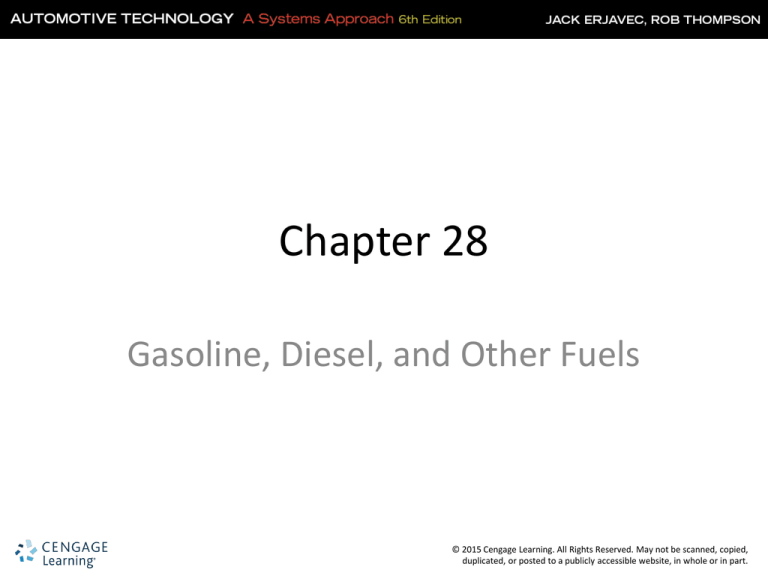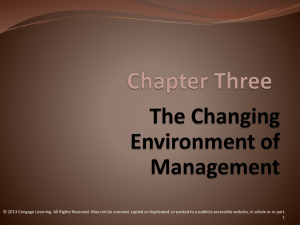
Chapter 28
Gasoline, Diesel, and Other Fuels
© 2015 Cengage Learning. All Rights Reserved. May not be scanned, copied,
duplicated, or posted to a publicly accessible website, in whole or in part.
Crude Oil
• A fossil fuel
• Varies in appearance
• Composition varies, but is typically:
– 84% carbon
– 14% hydrogen
– 1 – 3% sulfurs
– Less than 1% nitrogen, oxygen, metals, and salts
© 2015 Cengage Learning. All Rights Reserved. May not be scanned, copied,
duplicated, or posted to a publicly accessible website, in whole or in part.
Petroleum Products
•
•
•
•
•
•
•
Lubricating oil
Grease
Asphalt
Kerosene
Diesel fuel
Gasoline
Natural gas
© 2015 Cengage Learning. All Rights Reserved. May not be scanned, copied,
duplicated, or posted to a publicly accessible website, in whole or in part.
Hydrocarbons
• The number of carbon atoms in HC molecule
chain defines its length
• When combined with the number of hydrogen
atoms is called a chain
• The shortest hydrocarbon is methane, CH4,
which is a very light gas
© 2015 Cengage Learning. All Rights Reserved. May not be scanned, copied,
duplicated, or posted to a publicly accessible website, in whole or in part.
© 2015 Cengage Learning. All Rights Reserved. May not be scanned, copied,
duplicated, or posted to a publicly accessible website, in whole or in part.
42 Gallon Barrel of Crude Oil Produces
© 2015 Cengage Learning. All Rights Reserved. May not be scanned, copied,
duplicated, or posted to a publicly accessible website, in whole or in part.
Refining
• Separates the
hydrocarbons into
useful substances
• Very few of the
fractions are usable
without treating and
cleaning
• Some fractions are
altered to be used for a
specific application
© 2015 Cengage Learning. All Rights Reserved. May not be scanned, copied,
duplicated, or posted to a publicly accessible website, in whole or in part.
Chemical Processing
• Some fractions are processed to break
down long chains into shorter chains
• This process is called cracking
• Hydrocarbon structure can be rearranged:
– Often used to make octane boosters
© 2015 Cengage Learning. All Rights Reserved. May not be scanned, copied,
duplicated, or posted to a publicly accessible website, in whole or in part.
© 2015 Cengage Learning. All Rights Reserved. May not be scanned, copied,
duplicated, or posted to a publicly accessible website, in whole or in part.
Concerns
• Fossil fuels used for many
purposes due to high
energy density
• Even though abundant,
usage still increasing
• Burning HCs releases CO2
• Increased CO2 in the
atmosphere has been
linked to global warming
© 2015 Cengage Learning. All Rights Reserved. May not be scanned, copied,
duplicated, or posted to a publicly accessible website, in whole or in part.
Gasoline
• A mixture of about 300 ingredients
• Chemically represented as C8H15
• Oil refiners must meet standards set by the
American Society for Testing and Standards, the
EPA, and some state requirements
• Major factors affecting fuel performance:
– Antiknock quality, volatility, sulfur content, and deposit
control
© 2015 Cengage Learning. All Rights Reserved. May not be scanned, copied,
duplicated, or posted to a publicly accessible website, in whole or in part.
Antiknock Quality
• Represented by the octane number
• Two methods used to determine octane
number:
– Motor octane number (MON)
– Research octane number (RON)
• A test sample of fuel is used in a laboratory
engine
© 2015 Cengage Learning. All Rights Reserved. May not be scanned, copied,
duplicated, or posted to a publicly accessible website, in whole or in part.
Antiknock Index
• Average of RON and
MON (R+M/2)
• Displayed on fuel pump
• Most engines operate
on regular gasoline
• Higher octane fuel
burns slower than lowoctane fuel
© 2015 Cengage Learning. All Rights Reserved. May not be scanned, copied,
duplicated, or posted to a publicly accessible website, in whole or in part.
Factors That Affect
Engine Knock
• Fuel mixture
• Over advanced
ignition timing
• Compression ratio
• Valve timing
• Turbocharging or
supercharging
• Coolant temperature
• Excessive carbon
deposits
• Air inlet temperature
• Combustion chamber
shape
• Octane number
© 2015 Cengage Learning. All Rights Reserved. May not be scanned, copied,
duplicated, or posted to a publicly accessible website, in whole or in part.
Volatility
• Readily evaporates so gas vapor adequately
mixes with air for combustion
• Gasoline volatility affects:
– Cold starting and warm-up
– High altitude operation
– Crankcase oil dilution
© 2015 Cengage Learning. All Rights Reserved. May not be scanned, copied,
duplicated, or posted to a publicly accessible website, in whole or in part.
Volatility (Cont.)
• Gasoline is blended for summer use and
winter use
• Fuels in high altitude areas must have higher
volatility
• Volatility most commonly measured by the
Reid vapor pressure test
© 2015 Cengage Learning. All Rights Reserved. May not be scanned, copied,
duplicated, or posted to a publicly accessible website, in whole or in part.
Sulfur Content
• Water forms when hydrogen in the HCs are
burned
• Water leaves engine as steam but condenses
back into water
• When sulfur in the fuel burns it combines with
O2 to form sulfur dioxide
• SO2 can combine with water to form sulfuric
acid
© 2015 Cengage Learning. All Rights Reserved. May not be scanned, copied,
duplicated, or posted to a publicly accessible website, in whole or in part.
Basic Gasoline Additives
•
•
•
•
Anti-icing or deicer
Metal deactivators and rust inhibitors
Gum or oxidation inhibitors
Detergents
© 2015 Cengage Learning. All Rights Reserved. May not be scanned, copied,
duplicated, or posted to a publicly accessible website, in whole or in part.
Basic Gasoline Additives (Cont.)
•
•
•
•
•
Oxygenates
Ethanol
Methanol
MTBE
Aromatic hydrocarbons
© 2015 Cengage Learning. All Rights Reserved. May not be scanned, copied,
duplicated, or posted to a publicly accessible website, in whole or in part.
© 2015 Cengage Learning. All Rights Reserved. May not be scanned, copied,
duplicated, or posted to a publicly accessible website, in whole or in part.
Gasoline Quality Testing
• Reid Vapor Pressure
– Measures the volatility of the fuel
– Affects how an engine runs in cold weather
• Alcohol Test
– Excessive alcohol can cause corrosion and damage
to rubber components
– May cause driveability complaints
© 2015 Cengage Learning. All Rights Reserved. May not be scanned, copied,
duplicated, or posted to a publicly accessible website, in whole or in part.
Knowledge Check
• What are three additives used in gasoline?
© 2015 Cengage Learning. All Rights Reserved. May not be scanned, copied,
duplicated, or posted to a publicly accessible website, in whole or in part.
Alternative Fuels
• Renewable fuels are derived from non-fossil
sources
• Biomass fuels can be used in internal
combustion engines and tend to be carbonneutral
• Ethanol and methanol fuels, such as E85
• Already used as oxygenates in gasoline
© 2015 Cengage Learning. All Rights Reserved. May not be scanned, copied,
duplicated, or posted to a publicly accessible website, in whole or in part.
Ethanol
• High quality, low cost, high octane fuel
• Burns cleaner than gasoline
• Produced from corn, sugar cane, grains, and
other biomass waste
• Commonly used in E10 and E85 blends
• Most vehicles can use E10
© 2015 Cengage Learning. All Rights Reserved. May not be scanned, copied,
duplicated, or posted to a publicly accessible website, in whole or in part.
Ethanol (Cont.)
• Produced in the U.S.
and can reduce reliance
on foreign oil
• Few vehicle
modifications needed
• Cleaner emissions than
gasoline
• Helps keep fuel system
clean
• Can absorb moisture,
which can separate in
fuel tank
• Weak infrastructure
• Has a negative energy
balance
• E85 contains about 25%
less energy by volume
than gasoline
© 2015 Cengage Learning. All Rights Reserved. May not be scanned, copied,
duplicated, or posted to a publicly accessible website, in whole or in part.
Methanol
• A clean burning alcohol fuel
• Often made from natural gas but can be made
from coal and biomass
• Used in blends of M15 and M85
• Blending with gasoline improves cold weather
starting ability
© 2015 Cengage Learning. All Rights Reserved. May not be scanned, copied,
duplicated, or posted to a publicly accessible website, in whole or in part.
Propane (LP-gas)
• Liquefied petroleum gas is used by many
fleets
• Stored as a liquid
• Produces less HC, CO2, and CO
• Slight engine power reduction from reduced
cylinder filling
© 2015 Cengage Learning. All Rights Reserved. May not be scanned, copied,
duplicated, or posted to a publicly accessible website, in whole or in part.
Compressed Natural Gas (CNG)
and Liquefied Natural Gas (LNG)
•
•
•
•
•
Abundant and less expensive than gasoline
Clean burning with 25% less CO2 emitted
Stored at 2400, 3000, or 3600 psi
Requires large storage tanks
LNG requires less space but must be stored
and dispensed at very low temperatures
© 2015 Cengage Learning. All Rights Reserved. May not be scanned, copied,
duplicated, or posted to a publicly accessible website, in whole or in part.
CNG Storage
© 2015 Cengage Learning. All Rights Reserved. May not be scanned, copied,
duplicated, or posted to a publicly accessible website, in whole or in part.
P-Series Fuel
• Blend of natural gas liquids, ethanol, and
biomass-derived co-solvents
• Each gallon of P-series fuel emits about 50%
less CO2, 35% less HC, 15% less CO
• Could be 96% domestically derived
• More than 60% of content is renewable
© 2015 Cengage Learning. All Rights Reserved. May not be scanned, copied,
duplicated, or posted to a publicly accessible website, in whole or in part.
Hydrogen
•
•
•
•
Can be extracted from many sources
Currently has a negative energy balance
Liquefied hydrogen stored at -423°F (-253°C)
Hydrogen fuel engines typically produce less
power
• Very little infrastructure
© 2015 Cengage Learning. All Rights Reserved. May not be scanned, copied,
duplicated, or posted to a publicly accessible website, in whole or in part.
Fuel Cell Electric Vehicles
• FCEVs have electric motors
• A fuel cell generates electricity for the motor
and/or battery
• May use hydrogen or other fuel as the energy
source
• Pure water and heat are the only emissions
© 2015 Cengage Learning. All Rights Reserved. May not be scanned, copied,
duplicated, or posted to a publicly accessible website, in whole or in part.
Toyota FCV Concept
© 2015 Cengage Learning. All Rights Reserved. May not be scanned, copied,
duplicated, or posted to a publicly accessible website, in whole or in part.
© 2015 Cengage Learning. All Rights Reserved. May not be scanned, copied,
duplicated, or posted to a publicly accessible website, in whole or in part.
Flex Fuel Vehicles
• Designed to run on
something other than
gasoline
• Bi- or multiple-fuel
vehicles can use more
than one fuel
• May have two separate
fuel tanks
• Operate on one fuel or
the other
© 2015 Cengage Learning. All Rights Reserved. May not be scanned, copied,
duplicated, or posted to a publicly accessible website, in whole or in part.
E85
© 2015 Cengage Learning. All Rights Reserved. May not be scanned, copied,
duplicated, or posted to a publicly accessible website, in whole or in part.
Flexible Fuel Vehicles (FFV)
• Can use ethanol and/or gasoline or a mixture
of the two
• Stored in the same fuel tank
• PCM determines fuel used by the HO2S and
fuel trim readings
© 2015 Cengage Learning. All Rights Reserved. May not be scanned, copied,
duplicated, or posted to a publicly accessible website, in whole or in part.
Knowledge Check
• Technician A says all gasoline-powered
vehicles can use E85 fuel. Technician B says
only flex-fuel vehicles can use E85. Who is
correct?
© 2015 Cengage Learning. All Rights Reserved. May not be scanned, copied,
duplicated, or posted to a publicly accessible website, in whole or in part.
Diesel Fuel
• Has about 15% more energy than gasoline
• Small, high speed diesel engines require high
quality, high volatility fuel
• Diesel volatility measured by a cetane rating
• Two grades of diesel fuel, Number 1 and 2
• Number 2 is most popular and available
© 2015 Cengage Learning. All Rights Reserved. May not be scanned, copied,
duplicated, or posted to a publicly accessible website, in whole or in part.
© 2015 Cengage Learning. All Rights Reserved. May not be scanned, copied,
duplicated, or posted to a publicly accessible website, in whole or in part.
Diesel Fuel (Cont.)
• Is a high sulfur content fuel
• Diesel engines emit particulates, called soot
• High combustion temperatures produce high
NOx emissions
• Diesel fuel prone to waxing or solidifying in
cold weather
© 2015 Cengage Learning. All Rights Reserved. May not be scanned, copied,
duplicated, or posted to a publicly accessible website, in whole or in part.
Ultra-Low Sulfur Diesel Fuel
• Previous standard
allowed up to 500 PPM
• 2007 standard is 15
PPM
• Allows diesels to emit
less NOx, soot, and
other sulfur compounds
© 2015 Cengage Learning. All Rights Reserved. May not be scanned, copied,
duplicated, or posted to a publicly accessible website, in whole or in part.
Bio Diesel
• Fuels derived from renewable biological
sources:
– Animal fats
– Recycled restaurant greases
– Vegetable oils
• Can be used directly or blended
© 2015 Cengage Learning. All Rights Reserved. May not be scanned, copied,
duplicated, or posted to a publicly accessible website, in whole or in part.
Bio Diesel (Cont.)
• Advantages include:
– Reduce foreign oil dependence
– Carbon neutral
– Decreased HC emissions by 50%
– Nearly eliminates sulfur emissions
– CO emissions decreased an average of 48%
– PM emissions reduced by 47%
– Smoother, quieter, longer diesel engine life
© 2015 Cengage Learning. All Rights Reserved. May not be scanned, copied,
duplicated, or posted to a publicly accessible website, in whole or in part.
Bio Diesel (Cont.)
• Disadvantages include:
– High production costs
– Not readily available
– Increases NOx emissions
– Cannot be used in vehicles built before 1992
without modifications to the fuel system
© 2015 Cengage Learning. All Rights Reserved. May not be scanned, copied,
duplicated, or posted to a publicly accessible website, in whole or in part.
Diesel Engines
• The fuel is ignited by the heat of compression
• Higher compression results in more efficiency
than a gasoline engine
• Modern diesels quieter and more efficient
than previous diesel engines
© 2015 Cengage Learning. All Rights Reserved. May not be scanned, copied,
duplicated, or posted to a publicly accessible website, in whole or in part.
Modern Diesel Engine
© 2015 Cengage Learning. All Rights Reserved. May not be scanned, copied,
duplicated, or posted to a publicly accessible website, in whole or in part.
Diesel Combustion
• Combustion can take
place in three steps
© 2015 Cengage Learning. All Rights Reserved. May not be scanned, copied,
duplicated, or posted to a publicly accessible website, in whole or in part.
Engine Control Systems
• All 2007 and newer light-duty (14,000 lb GVW)
diesels are equipped with OBD II
• Some unique monitors for diesels include
– EGR cooler monitor
– Oxidation catalyst efficiency monitor
© 2015 Cengage Learning. All Rights Reserved. May not be scanned, copied,
duplicated, or posted to a publicly accessible website, in whole or in part.
Diesel Fuel Injection
• Direct injection into
combustion chamber
• Many modern diesels
use common rail
injection
© 2015 Cengage Learning. All Rights Reserved. May not be scanned, copied,
duplicated, or posted to a publicly accessible website, in whole or in part.
Injector Nozzles
• Delivers the fuel to the cylinder
• Nozzle tip atomizes the fuel
• Fuel pressure and the time the injector is
open determines the amount of fuel delivered
© 2015 Cengage Learning. All Rights Reserved. May not be scanned, copied,
duplicated, or posted to a publicly accessible website, in whole or in part.
Electronic Unit Injection
• Uses a camshaft-driven
high-pressure fuel
pump
• PCM controls injector
opening time
• Did not have as precise
control as needed to
meet modern emission
standards
© 2015 Cengage Learning. All Rights Reserved. May not be scanned, copied,
duplicated, or posted to a publicly accessible website, in whole or in part.
Hydraulic Electronic Unit Injection
• Uses engine oil pressure to control injector
operation
• Used until 2010
• Proper maintenance is critical on HEUI
systems
© 2015 Cengage Learning. All Rights Reserved. May not be scanned, copied,
duplicated, or posted to a publicly accessible website, in whole or in part.
Common Rail Injection
• A fuel rail carries highpressure fuel to each
injector
• Each injector
independently controlled
by the PCM
• Used in all 2010 and
newer engines
© 2015 Cengage Learning. All Rights Reserved. May not be scanned, copied,
duplicated, or posted to a publicly accessible website, in whole or in part.
Glow Plugs
• Used to warm the air
and combustion
chamber area for cold
starts
© 2015 Cengage Learning. All Rights Reserved. May not be scanned, copied,
duplicated, or posted to a publicly accessible website, in whole or in part.
Solenoid Injectors
• Used in common rail
systems
• The solenoid opens to
allow fuel to flow to the
injector nozzle
• Controlled by the PCM
© 2015 Cengage Learning. All Rights Reserved. May not be scanned, copied,
duplicated, or posted to a publicly accessible website, in whole or in part.
Piezoelectric Injectors
• Have no moving parts
• Contain thin layers of
piezo material
• When current flow
through material, it
expands, allowing fuel
to flow through the
injector
© 2015 Cengage Learning. All Rights Reserved. May not be scanned, copied,
duplicated, or posted to a publicly accessible website, in whole or in part.
Fuel Delivery
• A low-pressure transfer
pump in the tank
supplies fuel to the
high-pressure pump
• May contain a water
separator
• Injection pump may be
timed to the engine
© 2015 Cengage Learning. All Rights Reserved. May not be scanned, copied,
duplicated, or posted to a publicly accessible website, in whole or in part.
Turbochargers
• Used on nearly all diesel
engines
• Many newer engines
use variable geometry
turbochargers
© 2015 Cengage Learning. All Rights Reserved. May not be scanned, copied,
duplicated, or posted to a publicly accessible website, in whole or in part.
Knowledge Check
• Technician A says glow plugs are used to ignite
the fuel in a diesel engine. Technician B says
glow plugs warm the engine to allow easier
starting in cold weather. Who is correct?
© 2015 Cengage Learning. All Rights Reserved. May not be scanned, copied,
duplicated, or posted to a publicly accessible website, in whole or in part.
Diesel Emission Controls
• Diesels emit carbon monoxide, hydrocarbons,
carbon dioxide, particulate matter (soot), and
oxides of nitrogen (NOx)
© 2015 Cengage Learning. All Rights Reserved. May not be scanned, copied,
duplicated, or posted to a publicly accessible website, in whole or in part.
Diesel Oxidation Catalysts (DOC)
• In use since 2007
• Flow through catalysts similar to those used
on gasoline engines
• Converts fuel-rich gases into heat
• Reduces CO, HC, and other compounds
© 2015 Cengage Learning. All Rights Reserved. May not be scanned, copied,
duplicated, or posted to a publicly accessible website, in whole or in part.
Diesel Exhaust Particulate Filter
• The DPF works with the DOC and EGR to
reduce NOx
• Over time, trapped particulate plugs the filter
• The PCM will perform a cleaning or
regeneration of the filter
• Requires the use of low-ash oil to prevent ash
loading of the filter
© 2015 Cengage Learning. All Rights Reserved. May not be scanned, copied,
duplicated, or posted to a publicly accessible website, in whole or in part.
Exhaust Gas Recirculation (EGR)
• Injects an amount of exhaust gas into
combustion chambers
• Reduces combustion temperatures and NOx
emissions
• An EGR cooler removes heat from the gas
before it enters the engine
© 2015 Cengage Learning. All Rights Reserved. May not be scanned, copied,
duplicated, or posted to a publicly accessible website, in whole or in part.
© 2015 Cengage Learning. All Rights Reserved. May not be scanned, copied,
duplicated, or posted to a publicly accessible website, in whole or in part.
Selective Catalytic Reduction (SCR)
• Fits between the DOC
and DPF
• Reduces NOx emissions
• Uses a reductant or
reducing agent
• Requires refilling as part
of normal maintenance
© 2015 Cengage Learning. All Rights Reserved. May not be scanned, copied,
duplicated, or posted to a publicly accessible website, in whole or in part.
Positive Crankcase Ventilation (PCV)
• Also called crankcase ventilation (CCV)
• Removes crankcase gases
© 2015 Cengage Learning. All Rights Reserved. May not be scanned, copied,
duplicated, or posted to a publicly accessible website, in whole or in part.
TDI Engines
• Turbocharged Direct
Injection
• Made by Audi and VW
• Use common rail and
piezoelectric injectors
• Variable geometry
turbo
© 2015 Cengage Learning. All Rights Reserved. May not be scanned, copied,
duplicated, or posted to a publicly accessible website, in whole or in part.
Diagnostics
• Most of the diagnostics is scan tool based
• Smoke diagnosis
– White smoke may be caused by a misfire, faulty
glow plugs, low compression, poor injector
operation, and coolant leaking into the cylinder
– Grey or blue smoke is caused by oil burning in the
cylinder
– Black smoke indicates excessive fueling
© 2015 Cengage Learning. All Rights Reserved. May not be scanned, copied,
duplicated, or posted to a publicly accessible website, in whole or in part.
Diagnostics (Cont.)
• Remove the glow plugs to perform a
compression test
• Cylinder power balance testing performed
with a scan tool
• Glow plug resistances should be equal
© 2015 Cengage Learning. All Rights Reserved. May not be scanned, copied,
duplicated, or posted to a publicly accessible website, in whole or in part.







